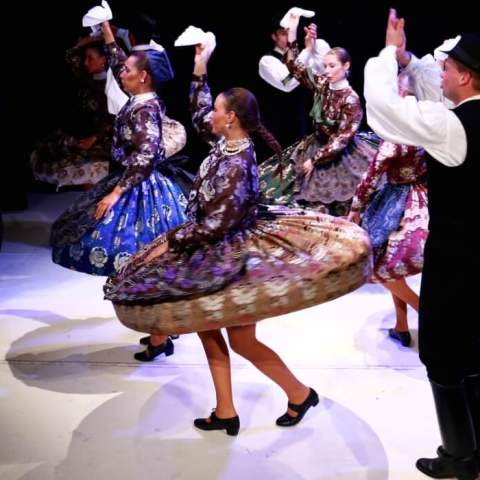
The dance culture of the Hungarian-speaking area can be divided into three major units: I. Western or Danube, II. Middle or Tisza, III. Eastern or Transylvanian dance dialect. The territory of today's Slovakia is affected by the western and central regions. Within the western dialect area, the north-western dialect area as well as Csallóköz and Szigetköz affect the territory of today's Slovakia. The main dance types of the north-western dialect area: girls' round dances, hoop dances, cross-stick cane dance, broom dance, shepherd dance, verbunk, the landscape versions of the csárdás. The special wedding dance of the dialect is the bride-laying candle dance. In the southern parts of the dialect, you can find mars, which is associated with amusements.
The typical representative dance type of Csallóköz and Szigetköz is verbunk. The remains of shepherd dances are represented by the broom and glass dances in Csallóköz and Szigetköz. The Szigetközi-Csallóközi inn is extremely grey and has a poor wealth of motifs. The wedding bride-laying candle dance is also known on the island, namely the so-called form of a labyrinth. The dance culture of this region is particularly coloured by the proximity of the German language border. Among the couple dances in Csallóköz and Szigetköz, the sottis polka is especially popular, often with a richer and more varied form than the local csárdás.
The middle dance dialect includes the dance repertoire of the ethnic groups living in the eastern half of today's Slovakia. Both the informal solo and the regulated group form of our verb can be found in this area. The wealth of motifs of the csárdás is in contact with that of the verb, girls' dances play a significant role, and among its wedding dances there is also the form of joking verbuvation related to the group of labyrinth dances. The bodnár dance of Erdőbénye is so far unique in the Hungarian-speaking area, and in terms of distribution in the Carpathian Basin, it is the easternmost data. In the area's dance heritage, the influence and coexistence of several cultures can be seen. The natural interaction of Slovak and Hungarian material was fertile for the cultures of both peoples. Folk dance is still popular among Hungarians in Slovakia to this day, and there are many local folk-dance ensembles. The Ifjú Szívek Táncegyüttes and the Szőttes Kamara Néptáncegyüttes are outstanding at the national level.

